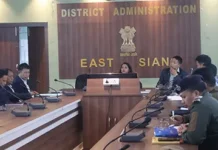[ Pradeep Kumar ]
ITANAGAR, 22 Dec: The executive committee of the Women’s Football Federation of India (WFFI), led by Kasim Ansari (chairman), Mukesh Sharma (president) and Dr Satyapal Singh Prajapati (patron), has evolved a pragmatic plan to ensure that Indian women footballers shine within and outside the country.
India is considered a subcontinental nation with 145 crore population, including 12.5% girls (18-24 years age group) whose potentials are yet to be tapped for lack of any sports university, modern auditorium, adequate training facilities and coaches, said WFFI central committee coordinator Rajesh Singh Rajput, adding that top-ranking corporate houses of India and aboard following tie up with them have agreed to support all projects from their corporate social responsibility (CSR) funds.
Funds would not be a problem, he said, adding that Goa Chief Minister Pramod Samant, after allotting 250 acres of land for a film city, has consented to allot 200 acres of land for developing a multipurpose advanced multi-storied auditorium.
Moreover, experts would be hired from the best universities and institutes from across the world for which Lucknow-based Dr Rahul Mishra has been interacting with many noted global varsities, said Rajput, sectary of yoga guru Ramdev. “It is a stepping stone. It is a matter of time. Wait and watch for a new era of women footballers to win laurels for India,” Dr Mishra said.
The WFFI would have state and district level committees for a five-year term with ‘tap the young’ mantra, he said, adding that National Youth Project president HP Biswas and senior journalist Pradeep Kumar Behera would head the Arunachal Pradesh committee besides being central committee members, while Behera would also be a member of the central publicity committee. Moreover, energetic Marina Doye of Seren village of Lower Siang district, who served as the coordinator of saints in Haridwar ashram, is also in the central panel.
Pointing out that hilly people of hilly states of Arunachal, Himachal Pradesh, Ladakh, Manipur, Meghalaya, Mizoram, Nagaland, Uttarakhand, West Bengal and Sikkim are physically very strong, the WFFI targets to tap and train young NE girls.
Football is the most popular sport in the world today. But the very word ‘football’ or ‘soccer’ would be incomplete in the Northeast without naming Nagaland footballer Talimeren Ao, who captained the Indian national football team at the 1948 Summer Olympic Games, and Arunachal’s Chow Indrajit Namchoom, who in the 60s had put the NE on the football map of India, being the first to play in Santosh Trophy, one of the most prestigious tournaments in India which continues to be a launch pad for youngsters even today.
But the state is not far behind as Arunachal’s women’s football team led by head coach Kipa Bharat won the Assam Rifles Sentinel Cup-2024 (NE zonal) after defeating Assam Rifles Women’s football team with a 2-0 score in the final match in Shillong on 8 July this year. Star player Yulam Lali was the standout performer, scoring a hat-trick to ensure easy victory.
With the state’s youths dragged into drug whirlpool, Chief Minister Pema Khandu and Deputy Chief Minister Chowna Mein have been conscientiously promoting games and sports after the state’s youths, without coaches, won many global laurels, particularly in karate and weightlifting. Thus, both would wholeheartedly welcome any proposal for developing advanced sports infrastructures for women.
Uttar Pradesh Chief Ministter Yogi Adityanath has assured all possible help and the WFFI team will soon approach NE chief ministers, he said, adding that the advisory committee includes top leaders of all religions, including Baba Ramdev.
The birth of modern football association dates back around 2nd to 3rd centuries BC when Cuju, an early type of competitive ball game using feet was played in China during the Han dynasty and early Qin dynasty, based on an attestation in a military manual. The Fédération Internationale de Football Association (FIFA) has cited Ccuju as the earliest form of football. (The contributor is a member of the WFFI Publicity Committee.)







